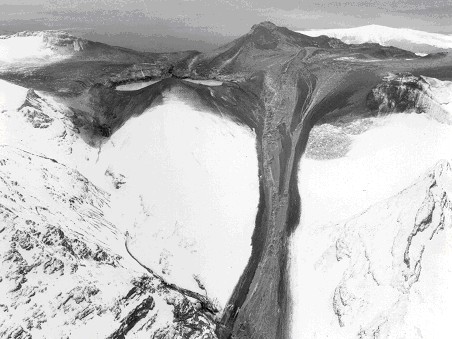

Why yes, click, certainly.
What follows is about a quite remarkable quantum explosion in Distributed Computing
B erkeley [University of California @ Berkeley]
O pen
I nfrastructure for
N etwork
C omputing
which is a system, and general-purpose software, for rapidly distributing all sorts of computation-intensive problems (in physics, meteorology, pure mathematics, chemistry, and many other scientific fields) to tens of thousands of ordinary Personal Computers all over the world, automatically linked via the Internet.
SETI@Home -- a computerized sifting through vast volumes of received radio signals from outer space to identify the first message sent to Us from Extraterrestrial Intelligence -- was the first problem to use the BOINC system and software, but BOINC quickly "opened up" to dozens of fascinating and scientifically important new projects, and huge numbers of PC users have enthusiastically volunteered to donate unused CPU (Central Processing Unit -- the computer's Brain Chip) time to solving these problems.
So anyway, the BOINC site was asking for a new Logo and other images, so I cooked up this one, and sent it to BOINC's Big Cheese at U-Cal Berkeley.
Here's some stuff about the Intersection of Science, Art, and an amazing new way to cure Teenagers of their Addiction to meaningless mega-violent Computer Games -- while finding a cure for Multiple Sclerosis.
Distributed Computing is one reason I don't completely chuck Planet Earth and move to Planet Vleeptron permanently. For a real dose of the Weltschmertz, compare what Earth People are doing in Iran and Iraq and Afghanistan and Guantanamo, with what thousands of other Earth People are doing on the Internet with Distributed Computing and BOINC.
===============
V.2
There are two reasons why this is in the style of Refrigerator Art. The first of course is that I am a crappy artist and stick figures is about as close to Life Study as I get. (A very undernourished young woman comes over once a week to pose for me, and when we're done, I make her eat a big pastrami sandwich.)
But as I screwed around with it, it dawned on me that when very little children see it on some adult's wall, they'll wonder why adults made and display Refrigerator Art, and they'll wonder what the image is trying to tell children and adults.
Here I should mention a very odd thing about this BOINC / Distributed Computing thing. All over the world, the hundreds of thousands of computer users who have linked up their unused computing power to solve dozens of important problems in medicine, chemistry, physics, pure math, are roughly split into two very different kinds of people.
The first are those drawn to Distributed Computing by scientific curiosity (even though you don't have to know squat about Science or Math to link up, you just have to know how to link up, which is about as difficult as clicking to get this e-mail).
But the other kind of D.C. enthusiast, these are technically called "overclockers," and they're in it for the Computer Game challenge, exactly like TCJ has the all-time high score on the Video Game at the pizzeria.
Overclockers spend all their money or max out the credit card on super-fancy computer Hardware, a gazillion gigs of RAM, the hottest CPU chip on the market, and tweak their computer's guts to make the system clock run much faster than the manufacturer recommends -- they are the Hot Rodders and Drag Racers of the Information Superhighway.
All these arcane scientific D.P. projects reward their volunteers with Stats -- points for all the hours of computation a volunteer's computer has contributed to the project. And the Overclockers, who couldn't give a rat's ass whether or not the project cures Alzheimer's or solves the Extended Riemann Hypothesis, all they want is Stats Stats and bragging rights to the massive amounts of Stats they've accumulated.
NEWS FLASH: This month Sony PlayStation 3 announced that it will automatically display the Folding@Home icon on player screens, and make it click-click easy for every PS3 owner to contribute to the Folding project (and amass mega-Stats). Finding the Cure for Cancer just took a Big Worldwide Power Leap.
All over the Web there are thousands of pages which barely mention the Science behind these projects (one may cure or eradicate malaria) or the Scientific aims of these projects, but are just long, long lists of Overclockers -- ordered High to Low -- and their various Stats. There are ferociously competitive national teams -- the Dutch Power Cows, the Scottish BOINC Team, BOINC.FR.Net, etc.
The Quest to hose up mega-Stats is so fierce that every Project now lists as its First Commandment:
Run this software on your own computer only, or obtain written permission to run this software on any computer you do not own.
... because they're always catching college students or insurance company computer geeks stealing Big Time from the boss's or the university's Big Mainframe to hose up the mega-Stats.
It's an authentic Variety of Theft, and sometimes the kids wind up (no photos available) in embarrassing little crime stories on Page 16. They never actually Go To Jail, but if they did, and their new cellmate asked, "What're you in for?", they'd have to say, "I stole 9000 hours of CPU time from my boss's mainframe to accumulate Stats for a Distributed Computing competition ..."
But Overclocker Culture means that lots of these freakazoids get addicted to Distributed Computing at the same age kids get addicted to ordinary Computer Games -- frighteningly young ages. But unlike "Saturn Marauders vs. Mechazoidz III" these BOINC addicts can actually boast that they are indeed finding the cures for diseases and solving profoundly significant questions in the sciences. (The Dutch Power Cows have won an important national award for their efforts. BOINC itself, at UC-Berkeley, runs on National Science Foundation grants, and a million volunteers.)
So the Refrigerator Art is intended to make a nine-year-old gamester ask questions and learn about a whole new world of Games -- just as challenging, just as competitive -- but which the Scientific World considers not as games at all, but as fundamental scientific research.
[In] V.1 all the D.C. stick people were Caucasian, and all were sitting Rightside-Up as we naturally do in the Northern Hemisphere, so in V.2 I have made some of the people Green and Purple and Non-White, and turned half the people Upside-Down, the way people compute in the Southern Hemisphere. BOINC and D.C. are Worldwide Endeavors.
(The Folding@Home map shows one Folder in the holy city of Mashhad and a handful of Folders in Tehran in Iran. (See map at top.) They help find a cure for genetic diseases, the West returns the favor by contemplating dropping The Big One on their evil heads.)
Well, I know my Weaknesses -- grievous and multiple -- as an Artist, and so I play to what pathetic strengths I possess. This is probably the first piece I've done in which Image and Visual Information outweigh Text and Typography.
It pleases me deeply that there are Clever People -- and even insane teenage Overclockers and insurance clerks who steal their boss's CPU time the way I used to steal stationery and office supplies -- who, in This World 2007, same Planet, right Here, right Now, are having So Much Fucking Fun doing So Much Good.
Who ever imagined Doing Good could be So Much Fun? Certainly not me. I've had the Fun, but very little of it cured cancer.
Bob
=====================
Dr. David P. Anderson
U.C. Berkeley Space Sciences Laboratory
Dear Dr. Anderson,
BOINC's "Logos and Graphics" page wasn't clear about whom to send submissions to, so please excuse this inbox invasion. Nevertheless I hope this bit of Refrigerator Art gives you some pleasure, and might be of use to BOINC.
I've been a distributed computing volunteer since soon after G.I.M.P.S. started, and now host Folding@Home. I've been amazed and fascinated at the ways such a magnificent idea has erupted and blossomed throughout the world.
Two years ago I noticed two clusters of host volunteers on the Folding@Home map of Iran, one in Tehran and the other in the big university city in the northeast. As already bad relations between the West and Iran have degenerated to frightening depths, distributed computing invites thoughtful women, boys, men, girls everywhere to ignore the blunders of governments and discover and expand knowledge to help Earth and enrich all who sail through space on her.
BOINC is something new under the Sun, and it rocks. I'm going to wear its t-shirt, and I wish BOINC and all who make it work the huge success it deserves.
Bob Merkin
Northampton Massachusetts USA











